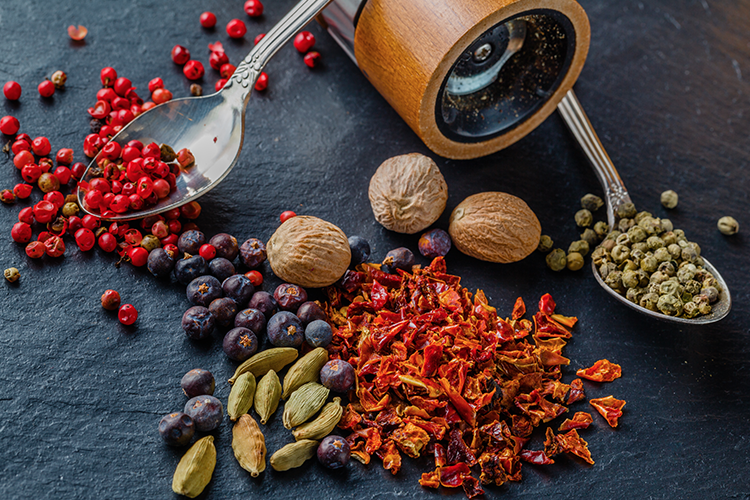Blog
Functional food super hero #3 – Spices
 The aroma spices can produce concocts feelings of comfort and deliciousness; a big food hug care of grandma’s ginger snaps, mulled wine, or the Friday night Rogan Josh takeaway.
The aroma spices can produce concocts feelings of comfort and deliciousness; a big food hug care of grandma’s ginger snaps, mulled wine, or the Friday night Rogan Josh takeaway.
But did you know of the almighty, nutritional power of spices? Even in the small quantities typically used, these flavour-packed seeds and barks are aching to enhance our wellbeing – which is probably why they taste so darn good!
Traded globally for centuries, the value of spices was in high demand before, during and after the Middle Ages in Europe, being imported from Asia and Africa. The various combinations of spices enhanced food flavour, and were used as medicines and as a preserving agent. They were even used as an embalming agent in ancient Egypt nearly 5000 years ago – that is some serious protective quality!
The options are endless
Working on a flavour profile, the beautiful quality of spices is that they can accompany and enhance both sweet and savoury dishes, meaning there is rarely an occasion when you cannot add a sprinkle to your meal. And every time you do, you are giving your body additional nourishment, a helping hand to get through another crazy day within another crazy week.
Spices can include nutmeg, cinnamon, ginger, cumin, coriander seed, cardamom, fennel seed, turmeric, sumac, allspice, pepper, cayenne, star anise, clove, mustard seed, paprika, saffron, and the list goes on! What is so special is the antioxidant activity of these little soldiers, raring to protect your cells from oxidative stress and the ravages of cellular ageing and chronic disease.
Here are some favourites and reasons why you should try and include them in your every day:
Cinnamon
This popular spice has been found to have anti-inflammatory, antimicrobial, and antioxidant properties; may have anti-tumour and immunomodulatory effects; and may improve risk factors for cardiovascular disease.(1) It is becoming very well known for benefiting those with type 2 diabetes and insulin resistance.(2)
If possible choose the Ceylon variety of cinnamon and enjoy with all manner of foods – have a teaspoon in a smoothie or a whole food unsweetened muesli; sprinkle over nut butter on sliced apple pieces or into blended frozen banana (the fabulous ‘nice-cream’ ice cream alternative); stir into stews, soups, bolognese, curries; add to steam veg, roast veg, mashed veg. The options are endless!
Ginger
A powerful anti-inflammatory agent, ginger has been studied for its potential effects in a variety of health conditions, including pain relief in those with osteoarthritis, and improved brain function. Preliminary studies are indicating its application in blood glucose control and reducing risk factors for cardiovascular disease.(3)
This delicious root has been used for centuries for treating nausea and stomach upsets – even in pregnancy. Ginger has been found recently to not only reduce PMS severity, but also reduces the duration of menstruation in women, reducing overall blood loss.(4,5)
Turmeric
Unless you have been living under a rock, you would have heard of turmeric, or its active phytoconstituent curcumin, and what a powerful anti-inflammatory it is. And, well, it is!
Turmeric has been found to reduce pain in arthritic conditions, and regular turmeric consumption has been linked with preventing Alzheimer’s disease.(6) In addition, it has cancer-protective effects; supports cardiovascular function and wound healing; and can reduce symptoms of inflammatory bowel disease and irritable bowel syndrome.(7)
While curcumin can be bought in capsule form to be taken at a therapeutic dose, unless you have a specific condition you need to address, instead add the powdered spice or freshly grated root to soups and smoothies, sprinkle over roast veg, mix into a mash, include in your marinade. You can even use it as a natural food colouring!
Get sprinkling!
Spices, overall, are inexpensive and outweigh most foods in gram for gram antioxidant potency.
So when you next create a meal or a snack, have a think about what spice you may be able to add. Get creative – if it doesn’t work, there is always next time. But if it does, you have just boosted deliciousness, while giving your health a helping hand.
By Angela Johson (BHSc Nut. Med)
References
- Gruenwald, J, Freder, J, & Armbruester, N (2010). Cinnamon and health. Critical Reviews In Food Science And Nutrition, 50(9), 822-834. https://doi.org/10.1080/10408390902773052
- Davis, PA & Yokoyama, W (2011). Cinnamon Intake Lowers Fasting Blood Glucose: Meta-Analysis. Journal of Medicinal Food, 14(9), 884-889. https://doi.org/10.1089/jmf.2010.0180
- Khandouzi, N et al. (2015). The Effects of Ginger on Fasting Blood Sugar, Hemoglobin A1c, Apolipoprotein B, Apolipoprotein A-I and Malondialdehyde in Type 2 Diabetic Patients. Iranian Journal of Pharmaceutical Research, 14(1), 131–40. https://doi.org/10.5812/ijem.57927
- Kashefi, F et al. (2015). Effect of ginger (Zingiber officinale) on heavy menstrual bleeding: a placebo-controlled, randomized clinical trial. Phytotherapy Research, 29(1), 114-119. https://doi.org/10.1002/ptr.5235
- Khayat, S et al. (2014). Effect of Treatment with Ginger on the Severity of Premenstrual Syndrome Symptoms. ISRN Obstetrics and Gynecology. https://doi.org/10.1155/2014/792708
- Ahmed, T, & Gilani, A (2014). Therapeutic potential of turmeric in Alzheimer’s disease: curcumin or curcuminoids?. Phytotherapy Research, 28(4), 517-525. https://doi.org/10.1002/ptr.5030
- Braun, L & Cohen, M 2010, Herbs and natural supplements: An evidence-based guide, 3rd edn, Elsevier, Chatswood NSW











